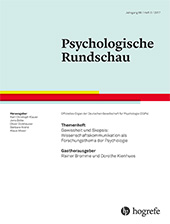Selektion, Integration und Evaluation
Wie wir das Internet nutzen, wenn wir uns über Wissenschaft informieren wollen
Abstract
Zusammenfassung. Laien treffen heute im Internet auf eine besonders große Vielfalt an Wissenschaftsinformationen. Wer hiervon profitieren will, muss Informationen auswählen, Verknüpfungen zwischen verschiedenen, oftmals konfligierenden Aussagen herstellen und deren Gültigkeit kritisch überprüfen. Anhand der Ergebnisse aus zwei Projekten aus dem SPP 1409 ‚Wissenschaft und Öffentlichkeit‘ zeigen wir, wie Laien diese Anforderungen bewältigen und auf welche kognitiven und motivationalen Ressourcen sie dabei zurückgreifen können. Obwohl erwachsene Laien bereits über vielfältige Kompetenzen im Umgang mit Wissenschaftsinformationen verfügen, deuten unsere Befunde auch auf einen Bedarf an pädagogischen Interventionen hin, um diese weiter zu verfeinern.
Abstract. On the Internet, laypeople can access a great variety of scientific information. To benefit from the wealth of information, laypeople need to select information, integrate information within and across documents, and critically judge the validity of competing knowledge claims. Based on the findings of two projects involved in the Special Priority Program 1409 „Science and the General Public,“ we demonstrate how laypeople master these affordances. We further identify cognitive and motivational resources laypeople can draw on when dealing with scientific information from the Internet. While adult laypeople already possess various competencies in dealing with scientific information, our findings also suggest a need for intervention to further develop the relevant competencies.
Literatur
(2016). Knowing who knows: Laypersons’ capabilities to judge experts’ pertinence for science topics. Cognitive Science, 40, 241 – 252.
(2016). Who knows? Explaining impacts on the assessment of our own knowledge and of the knowledge of experts. Zeitschrift für Pädagogische Psychologie, 30, 73 – 74.
(2015). From understanding to deference: Laypersons’ and medical students’ views on conflicts within medicine. International Journal of Science Education, Part B: Communication and Public Engagement, 5, 68 – 91.
(1998).
The efficacy of powerful/powerless language on attitudes and source credibility . In M. AllenR. W. PreissEds., Persuasion: Advances through meta-analysis (pp. 203 – 217). Cresskill, NJ: Hampton Press.(2011). Salvaging science literacy. Science Education, 95, 168 – 185.
(1951). The influence of source credibility on communication effectiveness. Public Opinion Quarterly, 15, 635 – 650.
(2008). Discerning the division of cognitive labor: An emerging understanding of how knowledge is clustered in other minds. Cognitive Science, 32, 259 – 300.
(2009). Looking the other way: Selective exposure to attitude-consistent and counter-attitudinal political information. Communication Research, 36, 426 – 448.
(2014). Lernen mit multiplen Texten zu kontroversen wissenschaftlichen Themen: Die Rolle der epistemischen Validierung. Unterrichtswissenschaft, 43, 24 – 38.
(2013). Credibility and trust of information in online environments: The use of cognitive heuristics. Journal of Pragmatics, 59, 210 – 220.
(2015). Social identity threat motivates science-discrediting online comments. PLoS ONE, 10.
(1986). Communication and persuasion. Central and peripheral routes to attitude change. New York, NY: Springer.
(2004). The persuasiveness of source credibility: A critical review of five decades’ evidence. Journal of Applied Social Psychology, 34, 243 – 281.
(2013). Easy to understand but difficult to decide: Information comprehensibility and controversiality affect laypeople’s science-based decisions. Discourse Processes, 50, 361 – 387.
(2012). The seduction of easiness: How science depictions influence laypeople’s reliance on their own evaluation of scientific information. Learning and Instruction, 22, 231 – 243.
(2014). You’d better ask an expert: Mitigating the comprehensibility effect on laypeople’s decisions about science-based knowledge claims. Applied Cognitive Psychology, 28, 465 – 471.
(2014). Science communication as political communication. Proceedings of the National Academy of Sciences, 111, 13585 – 13592.
(2013). Multiple document comprehension: An approach to public understanding of science. Cognition and Instruction, 31, 122 – 129.
(2014).
The content–source integration model: A taxonomic description of how readers comprehend conflicting scientific information . In D. N. RappJ. L. G. BraaschEds., Processing inaccurate information: Theoretical and applied perspectives from cognitive science and the educational sciences (pp. 379 – 402). Cambridge, MA: MIT Press.(2013). Dealing with uncertainty: Readers’ memory for and use of conflicting information from science texts as function of presentation format and source expertise. Cognition and Instruction, 31, 130 – 150.
(2016). Improving vocational students’ consideration of source information when deciding about science controversies. Reading and Writing. 29, 705 – 729.
(2014). Comprehending multiple documents on scientific controversies: Effects of reading goals and signaling rhetorical relationships. Discourse Processes, 51, 93 – 116.
(2012). “It should at least seem scientific!” Textual features of “scientificness” and their impact on lay assessments of online information. Science Education, 96, 187 – 211.
(2015). The Explaining Conflicting Scientific Claims (ECSC) Questionnaire: Measuring laypersons’ explanations for conflicts in science. Learning and Individual Differences, 37, 139 – 152.
(2013). Lost in Information? – Sozialpsychologische Aspekte der Selektion und Rezeption von journalistischen Online-Angeboten. Stuttgart: Kohlhammer.
(2014). A question of credibility – Effects of source cues and recommendations on information selection on news sites and blogs. Communications – The European Journal of Communication Research, 39, 435 – 456.
(2012). Selecting science information in Web 2.0: How source cues, message sidedness, and need for cognition influence users’ exposure to blog posts. Journal of Computer-Mediated Communication, 18, 80 – 96.
(2016). Who’s right: The author or the audience? Effects of user comments and ratings on the perception of online science articles. Communications – The European Journal of Communication Research, 41, 339 – 360.
(2015). Don’t keep it (too) simple: How textual representations of scientific uncertainty affect laypersons’ attitudes. Journal of Language and Social Psychology, 34, 251 – 272.



